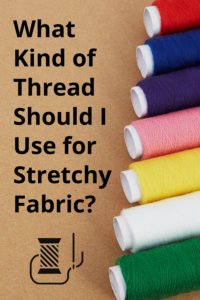Disclosure: This post may contain affiliate links. I earn a small commission when you click a link and make a purchase. Thanks for supporting SewingSociety.com!
I love sewing with spandex, cotton jersey, and other stretch fabrics. They are super comfy to wear because of their stretch. However, sewing stretchy fabric is a little more challenging than sewing standard cotton or canvas fabric. Let me show you a few tricks to keep you from losing your mind.
Use a Ballpoint Needle to Sew Stretchy Fabrics
The number one rule for sewing stretchy fabrics is to use a ballpoint needle or a stretch needle. Universal needles are too sharp. They leave holes and runs in your fabric. If you’re sewing a 4-way stretch fabric, like spandex, a stretch needle is best, but a ballpoint needle will work for all knits. For the most professional look, I recommend using a stretch twin needle.
Just as you should use a ballpoint needle when sewing stretchy fabrics, you should also use ballpoint pins. You can keep them on a separate pin cushion so they don’t get mixed up with your regular pins.
Choose a Stretch Stitch When Sewing Stretchy Fabrics
A straight stitch is not recommended for sewing stretchy fabrics. It doesn’t have enough give and breaks when your fabric is pulled and stretched. A straight stitch could also leave ugly, wavy hems. Instead of a straight stitch, select a zigzag or another stretch stitch on your sewing machine.
Most sewing machines have several stretch stitch options. The zigzag is my go-to, but you can use the lighting bolt stitch, triple stitch, or super stretch stitch. Just remember to check the alignment of your needle before using a stretch stitch to make sure it clears your presser foot. You don’t want to break your needle. A walking foot will also help you make better-looking seams when sewing knit fabric.
3. Select Polyester or Stretch Thread When Sewing Stretchy Fabrics
Cotton thread does not work well with stretchy fabrics because it breaks too easily. Always use polyester thread with a stretch stitch instead. However, I have one secret if you really want to use a straight stitch — it’s stretch thread.Maxi-Lock Stretch Thread is amazing for sewing with stretchy fabrics. You simply use it in your bobbin with a straight stitch. It provides enough stretch to prevent your seams from breaking. Wooly nylon is another stretch thread option that works well.
I love stretch thread, but it can be a little fussy to work with. Here are a few tips if you want to give it a try:
- Use a slightly longer stitch length than usual.
- Sew slowly because stretch thread tangles more easily than regular polyester thread.
- Use a walking foot to prevent your fabric from stretching as you sew.
- Wind stretch thread in your bobbin by hand.
4. Stabilize Your Fabric
Another thing that really helps when you’re sewing stretchy fabric is to use interfacing. Fusible tricot interfacing is the best option because of its stretch. I like to use it in the seams whenever I get wavy seams because the stability helps to prevent this. However, it is a ton of extra work. Knit stay tape is another excellent option.
Still need more help? Check out Linda Lee’s class on Craftsy, Sewing Fashion Knits: Beyond the Basics.
Pin this for later!







I have been considering doing a sewing project with a cotton jersey fabric this month. Thanks for pointing out that I will want to sue a zigzag stitch to help deal with the stretch of the fabric. That is great for me to understand because I have never sowed a stretchy fabric.
My brother xl2220nt machine can sew cotton fabric but when I try stretchy fabric all hell break loose from tangling to breaking threads and jamming etc. What is the cause pls.